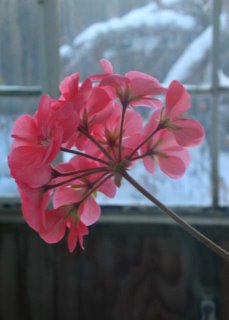 What’s blooming outside: Snow has not melted enough to see.
What’s blooming outside: Snow has not melted enough to see.What’s blooming inside: Aptenia, zonal geranium.
Animal sightings: No tracks in the snow.
Weather: Some rain Monday; snow Wednesday left at least three inches on the ground. Snow melted some each day, but temperatures remained cool enough that pockets linger between the grasses and at least an inch shrouds the beds near buildings.
Weekly update: Now that nature has donned its first mantle of snow, the only bright color I see through my window comes from zonal geraniums on my enclosed porch.
I didn’t intend to grow houseplants. They happened when I tried wintering expensive plants I was tired of replacing each spring. I didn’t have much luck, but the stumps of summer invoked the grand shrub of a geranium I saw in a plumbing shop in Philadelphia in the 1960s that filled the six foot window with trailing stems that always had blooms.
It took some years to find varieties that would survive my tough conditions. With a space heater set low, the porch temperature falls to 48 in the night, and rises to over 100 in the day. The extremes are less in summer, but the peaks are higher and consistent moisture impossible.
One parent of my plants, Pelargonium Zonale, was found at Meiringspoort on the Cape of Good Hope by Hendrik Oldenland when he was searching for potential commercial plants for the Dutch East India Company in 1689. Within a few years, cuttings were shipped back to Holland, and Mary Capell Somerset was growing them by 1710. Her husband, the Duke of Beaufort, developed their estate, Badminton, as an advisor to Charles II.
Another parent is the South African Pelargonium Inquinans which Henry Compton grew at Fulham Palace where he moved in 1676. His gardens became his retreat when James II suspended him as Bishop of London 1686 for refusing to reprimand one of his clergymen for preaching against Roman Catholicism.
Geraniums may not have taken sides in the years after the English civil war, but they definitely became capitalists. Pelargonium Horatus was developed for the bedding plant industry as a new species whose botanical content could change to meet the demands of the market, like any modern brand.
They made their debut with the masses at the Crystal Palace in 1854 when Joseph Paxton combined them with yellow calceolarias. The wealthy abandoned them as gaudy and gawky. Peter Grieve made them more garish with three-colored leaves in 1858.
Geraniums must have been a bright spot in Connellsville, Pennsylvania, in the 1940s when J. Robert Oglevee redirected the family nursery to flowers. During World War II, beehive ovens had burned day and night to convert the valley’s coal to coke for the steel mills of Pittsburgh. After the war, scarlet umbels followed Americans west to sunny California where field grown plants were cheaper than ones produced from cuttings back east.
Systemic diseases attacked in 1952. In the same years Eisenhower was decrying the development of the military industrial state, growers teamed with university researchers to find scientific solutions for their problems. Cultural indexing was developed to identify disease free plants for cut stock.
At Penn State, Richard Craig determined why seedlings were slow to emerge, then developed the first quick-germinating open-pollinated variety in 1962. Four years later, Lowell Ewart introduced the first F1 hybrid for Harris Seed, then moved to Michigan State. The flowers were smaller and the heads shattered, but seed grown plants were cheaper and less disease prone.
Vegetative stock suppliers ignored politics and followed the money to counter with new varieties. Oglevee began negotiating for rights to Wilhelm Elsner’s Dresden varieties in 1978. As soon as the Berlin Wall fell, Elsner expanded his licenses to growers in 19 countries in return for royalties on cuttings.
Goldsmith worked with growers in Kenya and Guatemala who ship rootless cuttings to wholesale greenhouses in this country. Fischer built a cutting production facility in Kunming, China in 2002.
The first plants I bought in 1997 were seedlings, Goldsmith’s Orbit and Sluis and Groot’s Ringo. Neither endured the summer heat. The ones I got the next year were Oglevee cuttings, and they didn’t survive either. It wasn’t until 2000 that some red and white plants, probably cuttings, I bought at the drug store not only made it through the summer but limped through the winter.
Buoyed by my success, I added some salmon cutting grown varieties marketed by Oglevee and more drug store plants. The weak died, but the fit regenerate their shed leaves and sporadically produce imperfect globes. I haven’t bought a new plant in five years.
Much as I’d like to think I’ve finally found the secret to growing geraniums, I probably owe my success to the genius of modern floriculture and the division of industry into discrete, untraceable units. However, it is just possible nature has intervened. Oglevee grows its cutting stock near Mexico City. It may be exposure to that climate in that altitude, even indirect, has created plants better able to survive northern New Mexico than ones grown in California.
Notes:
Lau, Angela. "Ecke Ranch Adds Blooms to the Leaves," San Diego Union-Tribune, 27 July 2006.
Corporate web sites for Goldsmith, Oglevee, and Fischer.
No comments:
Post a Comment